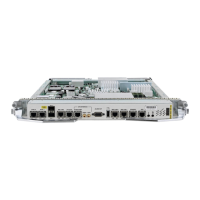RP/0/RSP0/CPU0:router(config)# l2vpn
RP/0/RSP0/CPU0:router(config-l2vpn)#
Enters L2VPN configuration mode.
Step 3 bridge group bridge-group-name
Example:
RP/0/RSP0/CPU0:router(config-l2vpn)# bridge group bg1
Enters Layer 2 VPN VPLS bridge group configuration mode.
Step 4 bridge-domain bridge-domain-name
Example:
RP/0/RSP0/CPU0:router(config-l2vpn-bg)# bridge-domain bd1
Enters Layer 2 VPN VPLS bridge group bridge domain configuration mode.
Step 5 vfi { vfi-name }
Example:
RP/0/RSP0/CPU0:router(config-l2vpn-bg-bd)# vfi v1
Configures the virtual forwarding interface (VFI) parameters and enters L2VPN bridge group bridge domain VFI
configuration mode.
• Use the vfi-name argument to configure the name of the specified virtual forwarding interface.
Step 6 multicast p2mp
Example:
RP/0/RSP0/CPU0:router(config-l2vpn-bg-bd-vfi)# multicast p2mp
Configures a point to multipoint pseudowire and enables the pseudowire in this VFI.
Step 7 signaling protocol bgp
Example:
RP/0/RSP0/CPU0:router(config-l2vpn-bg-bd-vfi-p2mp)# signaling protocol bgp
Enables BGP as the signaling protocol.
Step 8 Use the commit or end command.
commit - Saves the configuration changes and remains within the configuration session.
end - Prompts user to take one of these actions:
• Yes - Saves configuration changes and exits the configuration session.
L2VPN and Ethernet Services Configuration Guide for Cisco ASR 9000 Series Routers, IOS XR Release 6.3.x
316
Implementing Multipoint Layer 2 Services
Enabling BGP Autodiscover Signaling for P2MP PW on a VFI

